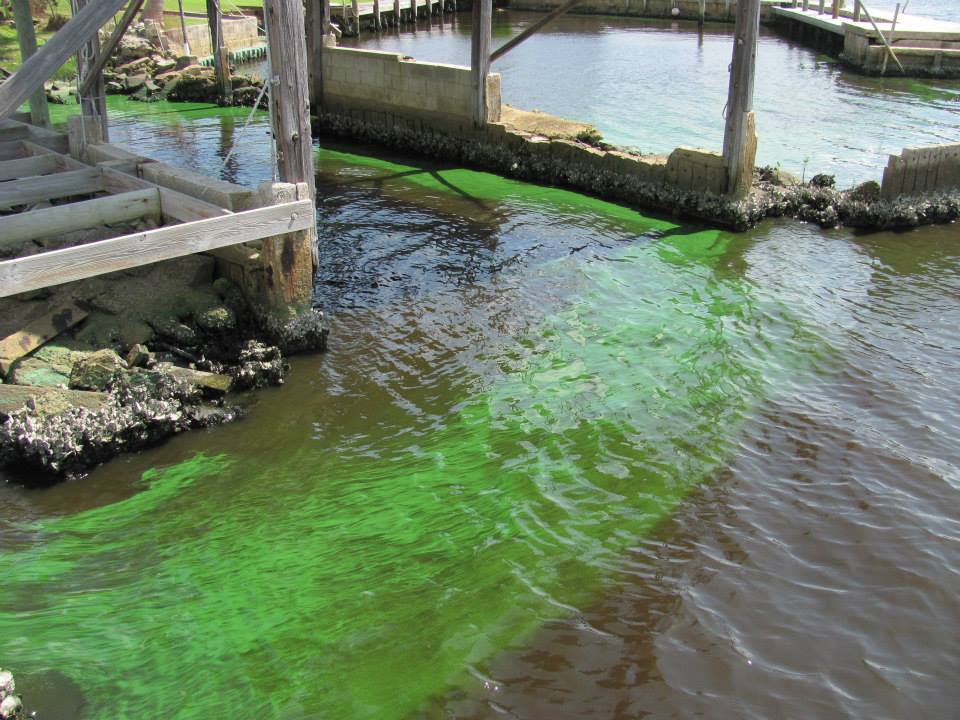The toxin microcystin, which is produced by cyanobacteria and has been blooming in the St. Lucie (and other places) all summer, thanks to freshwater discharges from Lake Okeechobee, is responsible for making people and animals sick.
But this month a USGS study confirmed that another species of cyanobacteria called Microcystis aeruginosa “can release toxins under stress when it touches saltwater.” And that is what is believed to have killed one beloved pet and nearly killed a couple others, along the St. Lucie estuary.
The following is an excerpt from the full story at Bullsugar.org:
“Ashley Guzi spent the night of September 1st waiting for the news that Costa, her four-year-old golden retriever, was dead. She stared at her phone, thinking about how she’d tell her children.
Meanwhile, the staff at Pet Emergency of Martin County in Stuart, Florida were spending the night trying to keep Costa alive. Tests showed her liver was failing, her blood wasn’t clotting normally, and she was bleeding into her stomach. She’d been poisoned. The dog would have died earlier in the day without plasma transfusions, but doctors needed to know what was killing her to give her a real chance of surviving.
As Costa was hanging on, Becky Harris’ miniature Pomeranian, Pandora, wasn’t expected to make it. Harris was asking about in-home euthanasia services, so her dog wouldn’t have to die alone in a hospital. Pandora’s symptoms were identical to Costa’s. She’d thrown up all day, finally so exhausted she couldn’t hold her head up, and her stomach was full of bloody fluid. When her tests came back with ALT scores so high they were almost unreadable, Harris knew what it meant. ALT is an enzyme released when the liver is stressed. The little dog that ran around mischievously on the beach that morning was dying of liver failure.
But Pandora had something going for her that Costa didn’t, as least not yet. Harris knew the cause: “They asked me if she could have eaten sugarless gum or rat poison. I said I knew what it was. It was the catfish she ate.”
Taking walks on the shore of the St. Lucie River was routine for Pandora, and that morning she’d gotten away from Harris and snatched a dead fish in the tideline. It wasn’t surprising that the dog got sick afterward, but Harris never imagined it might kill her.
It turned out to be the clue that helped save her life. When the emergency vets reached out to others in the area for information, they found more sick dogs, all living on the banks of the river, all dying of liver failure. The poison was in the water.
…Guzi never got the call she was dreading that night, but the next morning a neighbor helped make the connection her doctors were searching for. Costa had escaped from her yard and ran down to the river early the previous morning. She barely had time to sniff around the shoreline and take a quick drink before the neighbors recognized her and brought her back home, but it was long enough. It took three days for Costa to respond to treatment, but she made it. The dying dog that hadn’t even flinched at injections happily trotted home a week later.
Costa survived toxic algae poisoning, but her owners say she aged in a week. Things aren’t the same, though. “She tires quicker. Her face is whiter now. She aged in a week. She’s on liver supplements for the rest of her life, and the vets aren’t sure what kind of damage was done. They say she might develop liver cancer,” Guzi said. Costa will get quarterly blood tests to monitor her liver, and the other dogs will need the same kind of regular medical attention to track the long-term effects of their poisoning.
At least one local dog wasn’t as lucky. Finn, a nine-year-old standard poodle, died from the same symptoms that Costa and Pandora showed. His owners reported that necropsy results confirmed microcystin poisoning.”1
Bottom line, if you and your dog live near the river, do not take this warning lighting. While most swimmers along the river won’t swallow as much water like a dog taking a drink would, it’s still not safe to swim in or ingest- for you or your pets.
Vets in the area should now know about cyanobacteria and be ready to treat it but everyone needs to be alert and proactive. And if you see symptoms, ask for bloodwork to make sure your pups liver is healthy.
“Legislation requiring government agencies to weigh health risks before discharging water into coastal communities could reduce these dangers almost immediately. Building the infrastructure to redirect discharges into storage and filtration facilities and send clean water to the Everglades can address these risks in the long term–if the new systems have the capacity to offset the volumes that now flow into the St. Lucie and Caloosahatchee. But until those solutions are in place, Lake Okeechobee discharges will create high risks of toxic blooms in our estuaries, and residents and especially pets will remain vulnerable.”2
Stay safe and stay vigilant. XO- Erin












